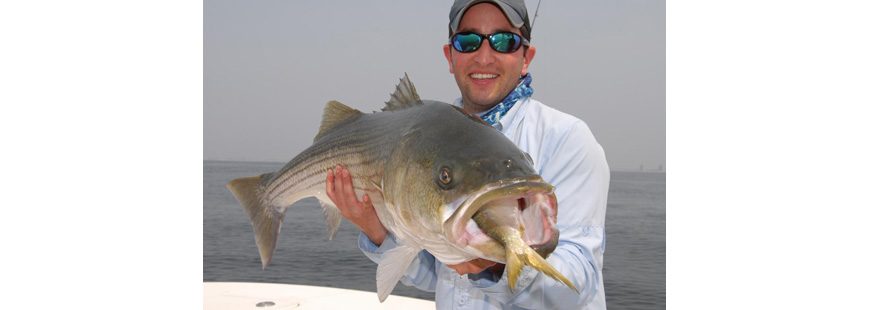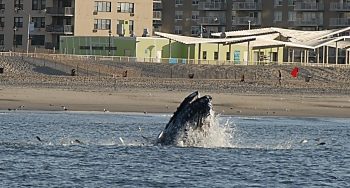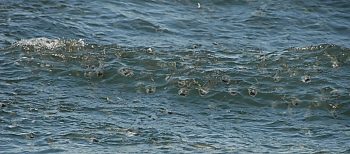Bass with bunker. Photo by Capt. John McMurray.
Are managers seriously thinking about increasing the menhaden quota again?
I’m not gonna waste any space here this time talking about all the benefits of recent menhaden concentrations. Not just because I’ve already done that here, but really, anyone who fishes at all gets it.
Massive schools of menhaden (aka bunker), not just on the South Shore of Long Island, but the North Shore also, have created a windfall for anglers in my state (NY). Stripers, bluefish, etc. show up and eat the crap out of these things. And the whales? Crazy whales… Close to the beach, feeding, mouth agape, bunker spraying out the sides, sometimes 20′ away from me. And who can remember a time where we had thresher shark concentrations this close to shore, in 40′ of water!
Yeah man…. The bunker thing has been awesome. Pretty blatant example of, “if there’s bait they will come.” But hey, you already know all this, so let’s move on.
Why do we have all these fish around these days, where just a few years ago, we didn’t? Well, industry lobbyists will insist it’s related to a unique set of environmental conditions, and I’m not gonna argue that this isn’t correct to some extent. But come on man, you and I both know intuitively that when you ratchet down harvest on something that was pretty much unregulated up until a few years ago, it’s gonna start coming back to its historical size and range.
Of course like a lotta things in the fishery management world, the dust hadn’t even settled before the usual people started clamoring for more fish. And next week, it’s possible, in fact likely, we’ll see a proposal for a quota increase of up to 40%.
Where does that come from? Well, scientists are saying that we can increase the quota by that much and still not technically overfish. There are several things wrong with managing to this “overfishing threshold,” like, for one, managers should be managing to a lower “target.” But the main one is that it doesn’t account for predator needs. In other words, how many need to stay in the water for stripers, bluefish, sharks, whales, etc.
Let this sink in for a moment. What we’re talking about here is actually a 50% increase over the quota that helped create the sort of concentrations that we’re seeing now, since they already raised the quota by 10% last year. To think that sort of increase, or any increase for that matter, won’t have an effect on the sort of thing we’re seeing now is stupid.
So, if you’ve benefited from these bunker concentrations like I have, or just understand that keeping a certain level of a supper-important forage fish in the water has far reaching benefits that exceed those of a few corporate special interests, then, well, you might want to weigh in here by letting your Commissioner know that any such increase is just a bad idea.
Menhaden History
To understand how we got here, it’s important to have a grasp on the history.
For a century and a half, the menhaden “reduction industry” has scooped up menhaden with purse seines by the billions and “reduced” them into fishmeal, oils, supplements, fertilizers, etc. Landings peaked at a whopping 1.6 billion pounds in 1956, yet because we were just hammering them, that number declined to “only” about 360 million pounds by 1969.
This, along with new technological efficiency consolidated the industry to the point that by 2005, there was only one reduction company remaining, Omega Protein in Reedville, Virginia.
By 2012, all states along the coast with the exception of Virginia had banned purse seine fishing for menhaden in state waters, mostly because of a combination of environmental concerns, the bait industry and recreational fishing interests. Still, federal waters (outside of 3 nautical miles) remain open.
Up until very recently, menhaden boats operated without any coastwide regulations.
In ’81 the Atlantic States Marine Fisheries Commission (ASMFC) took up the management of the fish, but it was much later before the Commission actually did anything to regulate it. Over the years, the management body acknowledged concerns early on, approving a number of constraining management alternatives, but ultimately never approved any of them, arguably because of industry pushback.
In 2001 ASMFC did pass Amendment 1 to the menhaden fishery management plan, providing specific biological, social, economic, ecological, and management objectives for the fishery, but, they passed no constraining measures.
Fast forward to 2006, and under pressure from the ENGO and recreational communities, the Commission capped the annual catch in the Chesapeake to Omega’s average Chesapeake catch for the previous five years. Although it was fought tooth and nail by industry, it wasn’t a particularly big win, because all it did really was prevent the fishery from expanding.
In 2009 a “benchmark” stock assessment was released. Scientists confirmed what anglers had suspected all along; overfishing of menhaden was occurring. Yet according to the current model the stock was not “overfished” due to what most of us considered were unsuitably low reference points.
Then in 2010, scientists found they underestimated the amount of fish taken by industry and overestimated menhaden’s spawning potential. The revision found that menhaden had been subject to overfishing for nearly half a century!
So, in 2011 the Commission passed Addendum V, which adopted more conservative reference points.
In 2012 the Commission passed Amendment 2, which implemented the first ever coastwide cap on harvest, which represented a 20% cut from previous levels.
As part of this amendment, state by state quota allocations were made based on catch history. 80% of the quota was allocated to the reduction fishery (Omega Protein), while 20% was split among the various large and small-scale bait operators in 15 states along the coast.
This proved to be hugely problematic, because in every state along the coast, there are less significant fisheries that mostly supply the local bait market. These small operations didn’t keep good records of their catch, while Omega and the big bait suppliers in New Jersey did. So, when it came time to divvy up the fish, there was no real way for the small guys to prove a history. Plus these much smaller-scale operations didn’t have the political clout or lobbying resources of the reduction industry or large-scale bait companies. And so, pretty much every state, save VA and arguably New Jersey got screwed.
There was another assessment in 2015, which differed A LOT from 2010’s assessment because the Commision used a kind of “selectivity curve” that had been advocated for by a scientist hired by Omega Protein. The “dome shaped selectivity,” model assumed that the largest, most fecund fish escape capture by commercial fishermen, and therefore are not factored into the models run by Commission scientists. This of course raised estimates of the numbers of menhaden in the ocean.
However, the assessment still showed that abundance (or numbers of menhaden) was at one of the lowest points in the last 50 years. Yes, there is more menhaden biomass (weight), but it’s in the form of big fish that are not adding numbers to the population. Because the health of the menhaden stock is measured in terms of reference points related to spawning, the age and mass of menhaden count for more than numbers of fish.
But hey… numbers are what matter most for predators right? But the assessment DID NOT account for this sort of predator/prey relationship.
So… based on the rosier picture the new stock assessment painted, ASMFC decided to increase the menhaden catch by 10% at the February 2015 meeting. It could have been worse. The new assessment allowed for a 30-40% increase.
Of course a 10% increase in quota wasn’t a good thing… But, at the same meeting the Commission voted to initiate Amendment 3, which will focus on developing and establishing “ecological reference points” (ERPs), which certainly was a good thing!
To translate, we’re talking about full consideration of those predator/prey relationships the recreational community has been asking for, for decades!
Which brings us to…
Where We Are Now
The ASMFC Menhaden board will meet next Wednesday (Aug 3) to decide what the menhaden quota will be in 2017.
There are soooo many reasons to avoid ANY sort of quota increase.
For one, the new stock assessment represents a 180-degree turnaround from the last one. It’s based on a lot of assumptions about “age-at-maturity” and “selectivity” (i.e. when a fish spawns, and when and how it’s caught). Both of those things are hard to determine with any real certainty. More important than any of that though is that it doesn’t effectively account for predator/prey interactions.
We’ve also got to acknowledge that the 2015 assessment doesn’t really indicate that the stock is doing great. As I mentioned above, while there are presumably more, larger menhaden around, overall abundance and recruitment (aka reproduction) is still pretty low. In fact the menhaden population was actually below the “target” fecundity level (the numbers of eggs they produce) in 7 of the last 10 years examined in the assessment.
Regardless, why the H would we make changes based on this past stock assessment, which only evaluated menhaden data up through 2013, when an update is coming out next year? Wouldn’t it be smarter to just wait for that?
We have no new data to base such an increase on. ALL of the Technical Committee’s projections are based on a single-species model. Thus the impacts of any increase in catch on predators like striped bass and weakfish in the system are simply unknown. Of course as anglers, we certainly know what sort of impact it will have. And it won’t be good!
Changing the quota without an understanding of the impacts to predators would seem to any reasonable person to run contrary to what ASMFC agreed on when they initiated Amendment 3. It was in large part a commitment to managing the species based on their role as forage.
And do we really want to have the sort of regulatory backlash that’s likely to come with an increase that could be taken away the following year, when we get the ecological reference points that will come with Amendment 3?
Lastly, any increase in quota at all would amount to peanuts for every state save VA and New Jersey. Their allocations are 85% and 11% respectively. Over 80% of the coast wide catch now comes from the lower Chesapeake and nearshore waters, an area that has had poor recruitment for 20 years. Sure, the assessment showed higher biomass in northern waters (off NJ, NY, and southern New England), but a catch increase now would come largely from the Chesapeake where abundance is down, likely exacerbating the impact on predators, particularly striped bass, down there.
Listen, I know NY and some of the other states need and deserve more fish to support their small-scale bait fisheries, but a quota increase across the board simply won’t get them that. Yes, the Commission needs to take a good thorough look at state allocation and reallocate more equitably. But the place for having a state like NY get more fish is in Amendment 3, where the allocation issue will be thoroughly examined.
I guess the real question right now is do we want to give Omega, and to a lesser extent Jersey, more fish when the rest of us are likely to get nothing out of it? The answer should be obvious.
The bottom line is that the Commission needs to stay the course and let menhaden recover to its historic range and former high abundance. The Commission should not risk undermining conservation gains we’ve made since Amendment 2 was first implemented.
If you agree, contact your Commissioner today! The message should be simple. No increase in menhaden quota at this meeting.
Your Commissioner can be reached here: ASMFC Commissioners.





Pingback: 'Make Fishing Great Again' - Marine Fish Conservation Network
Pingback: Don't Go Bottom-Fishing With Omega Protein - Omega Protein Corporation (NYSE:OME) - PakiMania
Pingback: ON BUNKER, IT’S TIME TO SHOW UP – Fissues
Pingback: On Bunker, It's Time To Show Up - Marine Fish Conservation Network